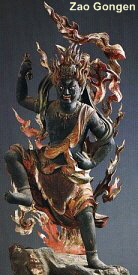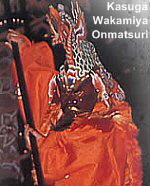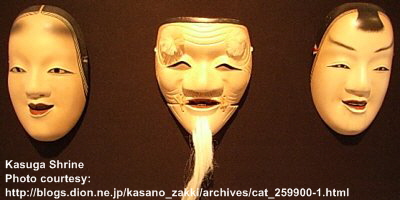|
|
|
|
 Gongen 権現 (Avatars of Japan) Gongen 権現 (Avatars of Japan)
Click here for list of Japan’s most popular Gongen
SUMMARY: Gongen (Jp. = Avatar) stems from the word Gonge 権化, which means transformation or manifestation in the Buddhist lexicon imported from China. In Japan, some say the Japanese term Gongen was derived from the posthumous title given to Tokugawa Ieyasu 徳川家康 (1542-1616), the first Shōgun 将軍 of the Edo period, for after his death Ieyasu was deified with the name Tōshō Daigongen 東照大権現 (Great Avatar). But research clearly demonstrates that the term appeared much earlier in Japan, at least by the early 14th century <see Kasuga Gongen below>. In Japan, the GONGEN moniker refers specifically to local Japanese kami (deities) who appear as temporary manifestations of the Buddhist deities. Phrased differently, Gongen refers to local Japanese deities who embody both indigenous and Buddhist elements, who represent a merging of the two traditions.
GONGEN is a Japanese term meaning "Avatar." Earlier Japanese words of similar meaning include Gonge 権化 and Kegen 化現, both from the Buddhist lexicon imported from China. Gongen refers generally to local Japanese kami (deities) who are considered manifestations or reincarnated forms of the imported Buddhist divinities that came from India, China, and Korea from the 6th century onward. In the history of Japanese sculpture, extant statues of Shinto kami (both in their Shinto form and in their Buddhist form) date only from the late 8th century and after. Says JAANUS: “The first instance of making [such] an image is believed to be that recorded in Tado Jingūji Garan Engi Shizaichō 多度神宮寺伽藍縁起資財帳 (Record of Properties of the Associated Temple of Tado Shrine), compiled in 801, which relates the story of how priest Mangan 満願 converted the kami of Tado to Buddhism in 763 and his subsequent portrayal of the kami in a sculpture. Thus, this artistic development appears to have occured well after the introduction of Buddhism to Japan in the mid 6th century.” <end JAANUS quote>
The term Gongen clarifies the Japanese origin of the deity and tells us the deity embodies a Kami-Buddhist blending. Despite the Tantric appearance of many Japanese Gongen deities, they are generally thought to be of Japanese origin. Syncretism is one of the great hallmarks of Japan’s religious history -- a feature that appeared early on and gained much prominence as early as the 9th century. Deities on either side of the Kami-Buddha matrix represent the “Unity of Buddhism and Shinto (Shinbutsu Shūgō 神仏習合). By Japan's late Heian and early Kamakura period, the practice of naming shrines with the names of their avatars became widespread, although I’m unsure if the term “Gongen” was used in shrine names. In the ancient and medieval periods, for example, the highest shrine ranking was Myōjin Taisha 明神大社 (Myōjin = Luminous Kami or Great Illustrious Spirit), not Gongen Taisha.
When the Meiji government forcibly separated Shinto and Buddhism (Shinbutsu Bunri 神仏分離) in the late 19th century, it abolished the "gongen" naming convention, and shrines thereafter became known as "Jinja." The Meiji government also actively promoted the term Daimyōjin 大明神 (Great Illuminator Deity) and demoted the earlier honorary title of Daigongen 大権現 (Great Avatar). This was considered one way for the government to promote Shinto supremacy over the imported Buddhist faith. Additionally, the Meiji government declared the ascetic mountain practices of Japan’s syncretic Shugendō sect (one of the first indigenous schools to incorporate both Kami and Buddhist beliefs) as superstitious and banned such practices, dealing a severe blow to the Shugendō cults. Some of Japan’s most beloved Gongen are presented below

List of Gongen in Japan
-
 Sanno Gongen (Sannō) 山王権現, the Monkey Avatar of the Tendai sect and guardian deity of Mt. Hiei 日吉山. Monkeys are patrons of harmonious marriage and safe childbirth at some of the 3,800 Hiei Jinja 日吉神社 shrines in Japan. These shrines are often dedicated to Sannō Gongen 山王権現 (lit. = mountain king avatar), who is a monkey. Sannō is the central deity of Japan's Tendai Shinto-Buddhist multiplex on Mt. Hiei 日吉山 (Shiga Prefecture, near Kyoto). The monkey is Sannō's Shinto messenger (tsukai 使い) and Buddhist avatar (gongen 権現). For more details on Sanno Gongen, click here. Sanno Gongen (Sannō) 山王権現, the Monkey Avatar of the Tendai sect and guardian deity of Mt. Hiei 日吉山. Monkeys are patrons of harmonious marriage and safe childbirth at some of the 3,800 Hiei Jinja 日吉神社 shrines in Japan. These shrines are often dedicated to Sannō Gongen 山王権現 (lit. = mountain king avatar), who is a monkey. Sannō is the central deity of Japan's Tendai Shinto-Buddhist multiplex on Mt. Hiei 日吉山 (Shiga Prefecture, near Kyoto). The monkey is Sannō's Shinto messenger (tsukai 使い) and Buddhist avatar (gongen 権現). For more details on Sanno Gongen, click here.
-
|

Kōfukuji Temple
Nara, 1226 AD
H = 86.5cm
Painted Wood
Pix: 日本の仏像 #28
|
|
 Zao Gongen (Zaō) 蔵王権現, the Mountain Avatar and guardian deity of Mt. Kimpu. Zaō is venerated nationwide, but especially in the mountain range extending from Yoshino to Kumano (the cradle of Japan’s Shugendō sects). Zaō Gongen is said to encompass both realms of the mandala -- the Kongōkai (Diamond Realm) and Taizōkai (Matrix Realm). The Kongōkai represents the wisdom/efforts of Dainichi Buddha to destroy illusion, while Taizōkai symbolizes Dainichi's teachings. These two mandala are central to Esoteric Buddhism in Japan. Zaō is considered an emanation of three Buddhist divinities -- Shaka Buddha, Kannon, and Miroku. Over the centuries, Zaō has been largely supplanted by Fudō Myō-ō, a major deity of the Shingon sect. For much more about Zao Gongen, click here. Zao Gongen (Zaō) 蔵王権現, the Mountain Avatar and guardian deity of Mt. Kimpu. Zaō is venerated nationwide, but especially in the mountain range extending from Yoshino to Kumano (the cradle of Japan’s Shugendō sects). Zaō Gongen is said to encompass both realms of the mandala -- the Kongōkai (Diamond Realm) and Taizōkai (Matrix Realm). The Kongōkai represents the wisdom/efforts of Dainichi Buddha to destroy illusion, while Taizōkai symbolizes Dainichi's teachings. These two mandala are central to Esoteric Buddhism in Japan. Zaō is considered an emanation of three Buddhist divinities -- Shaka Buddha, Kannon, and Miroku. Over the centuries, Zaō has been largely supplanted by Fudō Myō-ō, a major deity of the Shingon sect. For much more about Zao Gongen, click here.
- Kumano Sansho Gongen 熊野三所権現 (Three Avatars of Kumano). The Kumano triad is composed of three Shintō deities and their Buddhist counterparts. There is also a larger gongen group called the Kumano Jūnisha Gongen 熊野十二社権現 (Twelve Avatars of Kumano), which includes the main three plus nine lesser deities. A 13th deity, named Hirō Gongen 飛滝権現 (also read Hiryū Gongen), deifies the Nachi Waterfall in the Kumano area. The three main shrines are Hongū 本宮 (Kumano Nimasu Jinja 熊野座神社); Shingū 新宮 (Kumano Hayatama Jinja 熊野速玉神社); and Nachi 那智 (Kumano Fusumi Jinja 熊野夫須美神社). All three are located near the southern edge of Wakayama prefecture. To learn more about the famed three shrines of Kumano, plus other deity associations at Kumano, click here.
Three Avatars of Kumano (Shinto = Buddhist Counterparts)
-
 Doryo Daigongen (Dōryō) 道了大権現. The "Great Avatar Doryo." This man was a mountain ascetic before he became a Soto Zen monk. He was eventually appointed as head cook and administrator at Daiyūzan Temple 大雄山 (Kanagawa Prefecture). However, upon his death in 1411 AD, he vowed to become the guardian of the monastery and he is believed to have metamorphosed into a TENGU 天狗. For more details on Doryo Gongen, click here. Doryo Daigongen (Dōryō) 道了大権現. The "Great Avatar Doryo." This man was a mountain ascetic before he became a Soto Zen monk. He was eventually appointed as head cook and administrator at Daiyūzan Temple 大雄山 (Kanagawa Prefecture). However, upon his death in 1411 AD, he vowed to become the guardian of the monastery and he is believed to have metamorphosed into a TENGU 天狗. For more details on Doryo Gongen, click here.
- Izusan Gongen 伊豆山権現 (also known as Hashiriyu Gongen 走湯権現). The guardian deity of sacred mount Izusan 伊豆山 (a Shugendō site from around the Kamakura period) said to reside at a hot spring on Izusan in Shizuoka prefecture. Over time the deity was linked with Hakone Gongen 箱根権現 and Kourai Gongen 高麗権現 -- the three are considered one and the same. In the Meiji period, when Buddhism and Shintoism were forceably separated by the government, Izusan became a holy Shinto site and many of its Buddhist treasures were lost or scattered. Izusan Gongen is the Shinto manifestation of the Buddhist deity Senju Kannon 千手観音 (1000-armed Kannon).
- Kasuga Gongen 春日権現. The Kasuga Gongen Kenki Emaki 春日権現験起絵巻 (Miraculous Stories of the Gods of Kasuga Shrine), a set of 20 painted scrolls dated to 1309 and now part of the Imperial Collection, describe the avatars of Kasuga. The scrolls say the Kasuga deity will appear in at least three basic forms depending on the time and person involved. Scroll one mentions a female form, scroll four a baby-faced form, and scroll six a white-bearded dignitary. For more, please see the JAANUS entrees on Shinto Bijutsu 神道美術 and Shaji Engi-e 社寺縁起絵. Also see the Kasuga Shrine Web Site.
 
- Seiryu Gongen (Seiryū) 清滝権現. Female. Enshrined at Jingoji Temple 神護寺 in Takao 高尾 as the protective deity of the Shingon 真言 sect. Brought to Japan from China by Kūkai 空海 (774-836). Considered a manifestation of Nyoirin Kannon 如意輪観音, and one that grants long life, safe births, and wards off natural calamities. Structures in her honor were erected at the summit and foot of Mt. Takao in 1097. She usually appears as a lady wearing court robes (Jūnihitoe 十二単) and carrying a jewel (hōju 宝珠). Also associated with Zennyo Ryūō 善女竜王. <source = JAANUS>
- Tosho Daigongen (Tōshō) 東照大権現. This honorary title was bestowed on Tokugawa Ieyasu 徳川家康 (the first shogun 将軍 of the Edo period) after his death.
-
 Kojin (Kōjin) 荒神, 荒神様, 荒神さん. Syncretic Shinto-Buddhist deity of the kitchen and the cooking stove (kamado, 竃, 竈, also abbreviated as "kama"). Technically, Kōjin is not called a Gongen, but the deity’s iconography and attributes are nonetheless those of an avatar. Kojin (Kōjin) 荒神, 荒神様, 荒神さん. Syncretic Shinto-Buddhist deity of the kitchen and the cooking stove (kamado, 竃, 竈, also abbreviated as "kama"). Technically, Kōjin is not called a Gongen, but the deity’s iconography and attributes are nonetheless those of an avatar.
PHOTO. Called Sanbō Kōjin (less commonly known as Sanpō Kōjin) because the deity protects the Three Jewels (Sanbō 三宝), which are the Buddha, the Dharma (Buddhist law), and the Sangha (community of Buddhist believers). Another Japanese deity of the kitchen, Sanmen Daikokuten, shares similar iconography.
- Uba Gongen 姥権現 (Uba = 姥 or 媼)
Sacred Old Woman Boulder. Also called Old Woman Jizo 姥地蔵. Located at Mt. Iide 飯豊山 (Iideyama, Iidesan) in Aizu Prefecture. Says site contributor Gabi Greve: “In the past, women were strictly forbidden to climb this sacred mountain. Local legend says one devout woman ignored the restriction and attempted the ascent. But when she sat down to rest at the midway point, she was unable to get up again, and turned into a boulder. Today, when climbers pass this boulder, a short shower from the heaven might refresh them.” <See Gabi’s page for more>
- Kōya Shisho Gongen 高野四所権現 or
Kōya Shisha Myōjin 高野四社明神
Literally "Four Gongen of Mt. Kōya." The four tutelary deities of the Mt. Kōya Shingon complex in Wakayama Prefecture. The four are venerated especially at Amano Jinja 天野神社 (aka Niutsuhime Jinja 丹生都比売神社). The four are:
1. Niu Gongen 丹生権現 or Niu Myōjin 丹生明神; Shinto counterpart = Niutsu-hime no Ookami 丹生都比売大神
2. Kariba Gongen 狩場権現 or Kariba Myōjin 狩場明神; Niu's son; also known as Kōya Gongen 高野権現 or Kōya Myōjin 高野明神; Shinto counterpart = Takanomiko no Ookami 高野御子大神
3. Kehi Gongen 気比権現 or Kehi Myōjin 気比明神; deity from Fukui Prefecture added to group in Kamakura era; Shinto counterpart = Oogetsu-hime no Ookami 大食都比売大神.
4. Miyajima Gongen 厳島権現 or Miyajima Myōjin 厳島明神; deity from Hiroshima Prefecture added to group in Kamakura era; Shinto counterpart = Ichikishima-hime no Ookami 市杵島比売大神 (source of above list = www.niutsuhime.or.jp)
- Hakusan Shichi Gongen 白山七権現. Seven Gongen of Sacred Mt. Hakusan. A sacred mountain site from early times that practiced syncretic Shinto-Buddhist beliefs and Shugendo mountain asceticism. It is located along the borders of four prefectures (Fukui, Gifu, Ishikawa, and Toyama). From the 12th century onward, it was ruled by Enryakuji Temple 延暦寺 on Mt. Hiei 比叡 in Kyoto Prefecture, and thus copied the 21-shrine format (7-7-7 pattern) of the Sannō 山王 shrines at Mt. Hiei. The main deity is Shirayama-hime 白山比売 and her shrine-temple is known as Hakusan Hongū 白山本宮. Her group of seven shrines is the main group, and its seven deities are called the Hakusan Shichi Gongen 白山七権現. There is another grouping of three called the Hakusan Sansho Gongen 白山三所権現, and they are thought to represent the three deities of three mountains (Bessan 別山, Gozenpō 御前峰, and Oonanjimine 大汝峰). The Buddhist counterparts (honjibutsu 本地仏) of the three are sometimes given as Shō Kannon 聖観音, Jūichimen Kannon 十一面観音 and Amida 阿弥陀, but this can vary depending on the source. The central gongen deity at Hakusan is Hakusan Myōri Gongen 白山妙理権現. See our HAKUSAN PAGE for much more about the sacred Hakusan mountains and photos of its deities.
- Mikomori Gongen 御子守権現, also Mikomori Myōjin 御子守明神 of the shrine Mikumari Jinja 御子守明神. Also called Komori Myōjin 子守明神 and may appear in a deity-triad known as Mikomori Sannyoshin 御子守三女神 (details below). Following text courtesy of JAANUS. “This female deity of the Mikumari Jinja 吉野水分神社 is situated on a ridge above the village of Yoshino 吉野 in southern Nara. It is one of four major watershed shrines in old Yamato 大和 (i.e. Japan). Yoshino Mikumari appears in a record of 702 and was known as a site at which to pray for control of rain and water. Apparently through a misapprehension of the sound, Mikumari became known as Mikomori, a protector of children. Mikomori is one of the eight gongen of Yoshino (gongen being the forms taken by supernatural beings in order to manifest themselves on earth). There are twenty sculptures of the deity at Yoshino Mikumari Jinja. The most famous of these is that of Tamayorihime 玉依姫, dating from 1251. She appears in KOJIKI 古事記 (712) as the mother of Emperor Jinmu 神武. In this case she appears accompanied by two other deities and the three together are known as the Mikomori Sannyoshin. It is important to note that Tamayorihime is not identical with Mikomori Myōjin, since the latter is the collective deity of the whole shrine and includes a number of other deities. In paintings Mikomori may appear alone or in a triad. She is shown as a court lady, and she may be with children or shown holding a vajra (a symbol/weapon often held by Buddhist deities to represent their power to overcome evil). She and/or her shrine often appear in Yoshino Mandala 吉野曼荼羅. Mikomori Myōjin's Buddhist counterpart (honjibutsu 本地仏) is Jizō Bodhisattva 地蔵, and the bonji 梵字 (Siddham letter or mystical sound of the deity) for Dainichi Buddha 大日 of the Taizōkai Mandala 胎蔵界曼荼羅 may appear on paintings of her.” Above text courtesy of JAANUS.

LEARN MORE
- Zaō Gongen. One of the most important mountain deities of Japan's syncretic Shugendō (Shugendo) sects. Numerous photos and detailed history of this deity.
- Zao Gongen Statues at our Sister eStore
- GONGEN
Shinto Encyclopedia
Kokugakuin University, Japan
See this entry for good overview
- GONGEN
From JAANUS. The name Gongen is derived from Tōshō Daigongen 東照大権現, the title of Tokugawa Ieyasu 徳川家康 (1542-1616), the first shōgun 将軍, of the Edo period. Gongen is related to Gonge 権化, which refers to a reincarnated being in the Buddhist lexicon. Ieyasu expressed the wish to be deified after his death. His wishes were respected and his mausoleum at Nikkō Tōshōgū 日光東照宮 (1635) in Tochigi Prefecture hold his remains. The mausoleum's architectural style became known as Gongen Zukuri. Other examples include Kitano Tenmangū 北野天満宮 (1607) in Kyoto, and Ōsaki Hachimangū 大崎八幡宮 (1607) in Miyagi Prefecture.
- GONGEN PAGES FROM GABI GREVE
Konpira Daigongen 金毘羅大権現
Ii no Yama, Byaku-I Gongen 飯山白衣権現
Izuna Gongen, Iizuna no Gongen 飯網の権現
Akibagongen 秋葉権現
BUY STATUES ONLINE
- Buddhist-Artwork.com
Zao Gongen statues available for online purchase at our sister site, along with 100+ statues of other major Japanese divinities.


First Published = June 2, 2008
|
|